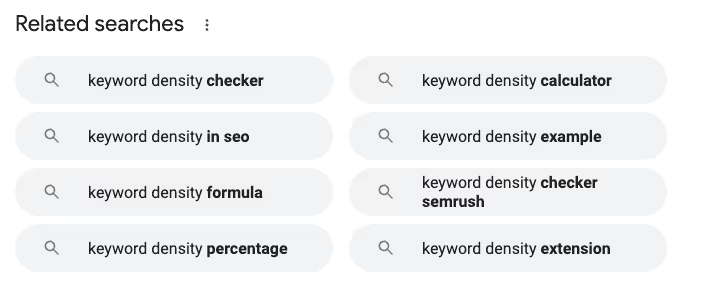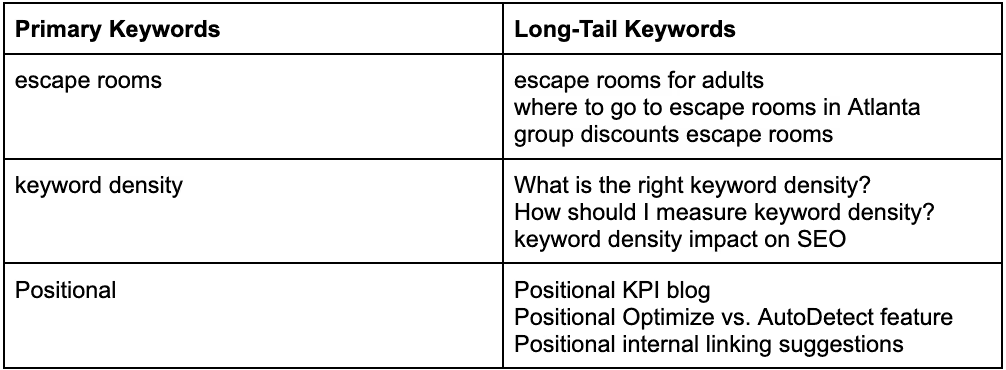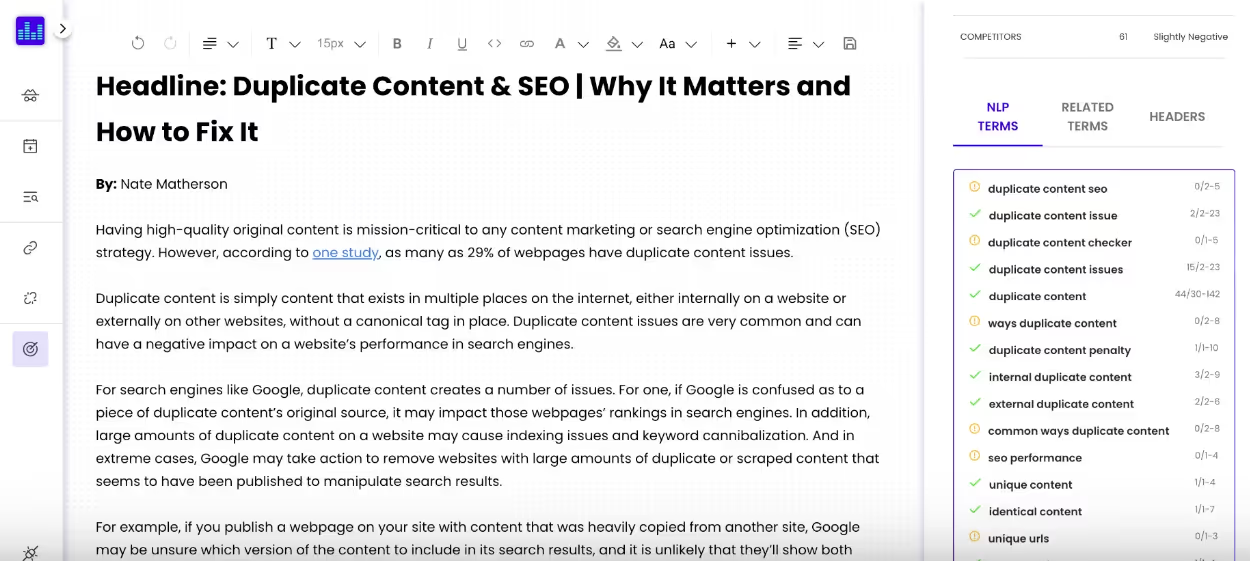Keyword density (or keyword frequency) is the number of times a keyword appears on a webpage, relative to the page’s total word count. It impacts how Google and other search engines rank the page and assess the relevance of its content.
You can measure keyword density by percentage, ratio, or total number. The more frequently a keyword appears on a page, the higher its density is — but higher isn’t always better. In this post, we'll give you the what, why, and how of keyword density, and we’ll explain some related best pest practices.
First, let’s explore the more technical aspects of keyword density.
What Is Keyword Density? | Measurements and Terminology
Keywords are critical in your SEO strategy.
As with any foundational metric, you’ll want to know how to determine keyword density and how to measure its impact. Keyword density shapes how a page performs on search engines — along with quality and accessibility.
Read any article on the topic, and it will tell you the same thing — keyword density matters, with a caveat. Too much, and your article is spammy. Too little, and you’ll live on the fifth page of Google search results forever, and you might miss out on ranking for important long-tail keywords.
The most important factor is the quality of your content; using relevant keywords to naturally support that content comes next. So how do you measure keyword density?
Keyword Density Calculation
Determining keyword density doesn’t require some complicated algorithm. Here’s a simple keyword density calculation you can use:
(Number of keyword occurrences / total words) x 100
For example, the keyword for this article — “keyword density” (you guessed it) — occurs 46 times. There are 1,928 words in this article. So our keyword density calculator would give us:
(46 “keyword density” occurrences / 1,928 words) x 100 = 2.39%
The measurements don’t stop here if you want more data. Let’s look at a more detailed keyword density percentage calculation that Google has historically used to judge the quality and relevance of your site: TF-IDF.
What Is TF-IDF?
It’s helpful to look at TF-IDF (term frequency–inverse document frequency) as two separate measurements.
TF (term frequency) is simply your keyword density.
IDF (inverse document frequency) looks at that keyword relative to its density across other pages on your site. While density looks at a keyword phrase in isolation (on one page), TF-IDF is Google’s way of assessing the bigger picture.
The “inverse” portion can be confusing, but think of TF-IDF as a synonym for rarity — the higher the value (on a scale from 0 to 1), the rarer. Words like “the” or “and” will be near 0, as they occur on every page with high frequency. But a phrase like “keyword density formula” will be closer to 1 for our website.
TF-IDF is relevant to you because it can help you prevent keyword cannibalization. Having primary keywords with higher TF-IDF (that is, rarer terms) will reduce the risk of cannibalization on your website.
What Is the Right Keyword Density?
We’ll keep the ideal keyword density simple: 1 or 2 keywords for every 100 words in your content, or around 1 to 2%, according to Matt Cutts on Google Search Central. This is based on Google’s recommended approach to keyword strategy — it’s not about overthinking density; rather, it’s about implementing keywords in a non-spammy, natural way.
Depending on the search term, a low keyword density like 0.5% can work as well as a high keyword density on Google and other search engines.
You might be thinking, “That’s not a high frequency” — and that’s intentional. The best keyword density isn’t always high density. Search engines don’t like pages that spam keywords to try to rank higher — it all comes down to the authenticity and helpfulness of the content. There are a number of tools, including Positional's Optimize, that can provide recommended keyword density for both primary keywords and long-tail keywords.
How Often Should I Use Specific Keywords?
The short answer is that there’s no hard-and-fast rule to using specific keywords. Search engines favor user feedback over formulas, and machine learning algorithms are evolving. Outdated technical methods and trying to “hack” your way to better SEO won’t work.
Specific keywords are relevant to the page. You want the content to feel natural, which means using specific keywords sparingly to retain impact and TF-IDF.
H1s and H2s are the most important places to have keywords and variations. Inserting keywords relevant to each header is a general first step in establishing keyword density.
As long as you’re not copying specific keywords and pasting them into places where they shouldn’t be, you probably don’t have to worry about your keyword frequency being too high. And as a best practice, it is always best to do what is most helpful for the reader.
How Should I Think About Keyword Variation and Long-Tail Keywords?
Focusing on a single key phrase isn’t how you land on the first page of Google. Enter keyword variation, a must-have in your SEO strategy and overall keyword density.
What Is Keyword Variation?
Keyword variants (also known as secondary keywords) are words and phrases adjacent to your target keyword. Take this article, for example — “keyword frequency” is a variation of “keyword density.”
Search engines consider keyword intent, or search intent, along with keyword density. Users may not search for the exact key phrase you’re optimizing content for, but if you have keyword variations included in your piece of content, those variations can improve your search rankings for longer-tail variations of the primary keyword in view.

The Related Searches feature in search engines is a great starting point for uncovering keyword variants.
For example, when you search for a plumber, you may use multiple search terms to find the right plumber, such as:
- plumbers near me
- plumbers in my area
- [city name] plumbers
- local plumber reviews
- best plumber for [plumbing issue]
Why Does Keyword Variation Matter?
By using variants of the primary keywords you are targeting, you will ultimately rank better for those variants in organic search.
You have to balance using keyword variants with avoiding using too many keywords in your content (keyword stuffing) — more on this later. Variation reduces the risk of keyword stuffing while extending your content’s reach.
Keyword variations work similarly to internal linking strategy, creating webs between content. These webs establish more connection points for your content to be relevant, and for your site to build topical authority.
This doesn’t mean you overload your content with 100 different keyword variations. As with good keyword density, finding a natural-sounding balance for your variants is best. Optimization is as much about the quality of the content as it is about the technical components.
What Are Long-Tail Keywords?

Often undervalued in SEO, long-tail keywords are more specific than primary and secondary keywords. They have lower search volume (specificity), but a stronger connection to search intent and are often very high intent.
There are two types of long-tail keywords: Supporting long-tail keywords, like keyword variants, which should be included into a piece of content. And then there are topical long-tail keywords which should often be broken out into separate standalone pieces of content to serve a very specific search intent.
Consider the graphic above — while it may be tempting to go after high-volume short-tail keywords, those will almost always be competitive. And over 70% of searches are in fact for long-tail keywords.
Including supporting long-tail keywords into your piece will ultimately help your piece of content rank for a large number of more specific keywords. And by including topical long-tail keywords into your pieces, you can improve overall topical relevance of your website and create fantastic internal linking opportunities.
Examples of Long-Tail Keywords
“Long” may be in the name, but that doesn’t make long-tail keywords complicated. They typically have around three to five words, and many long-tail keywords include the primary keyword.

How to Use Long-Tail Keywords
Let’s use the “escape rooms” example from the section above. If a user unfamiliar with escape rooms is looking for one, their search journey may begin with a basic primary keyword: “escape rooms.” It’s a less specific search, or a short-tail keyword.
Maybe local escape rooms have fine-tuned their SEO to rank high for this keyword, but it’s likely that national competitors for kids’ escape rooms may also pop up. So the user searches for “escape rooms for adults,” which is a more specific discovery search term. Now Google is learning what the user wants.
Still getting the national ads, your user searches for “where to go to escape rooms in Atlanta.” This is where the benefit of using long-tail keywords comes into play. It's less competitive but has action-oriented intent — Google will favor the long-tail optimized page. You'll rank higher for this specific term, and users are more likely to click through and convert.
Be Careful to Avoid Keyword Stuffing
If you’re new to keyword strategy, it can feel like a lot of “put this in here” and “don’t forget that.” But despite all the additive SEO best practices, one of the most common content mistakes is keyword stuffing — or overkill.
Keyword stuffing is an old-school technique — it means including as many primary and secondary keywords as possible in an attempt to game search engines. Google has cracked down on this practice, and now, it’s the one of the easiest way to end up with your content being penalized.
Again, keywords should be used in a natural way. It’s okay to try plugging in more keywords to increase frequency or to target long-tails more specifically, but:
- Only if you need more density.
- Only if it feels organic to your content flow and sentence structure.
Remember, a keyword density of 0.5% to 2% or 3% will feel natural and shouldn’t cause any problems.
Using Optimize to Target Keyword Density

With so many best practices and so much advice on good keyword density and SEO, trying to remember and implement everything on your own can be stressful.
With Positional's Optimize toolset, users are provided with recommended counts for each keyword, including long-tail keywords. Positional provides a suggested range for how often to use a keyword. These ranges are calculated by counting the number of times each specific keyword is used in top performing or ranking pages. In other words, Positional reverse engineers top performing results and will only suggest a keyword to include if at least two of the top performing pages are using a specific keyword within their pages.
As long as the user uses the keyword the minimum number of times, the user will get the points and the score will increase.
Optimize removes the guesswork. You can hit the ideal keyword frequency without going overboard, and the provided keyword variations eliminate the need for time-consuming research.
Final Thoughts
SEO continues to evolve, but targeting and using keywords effectively in your content has remained a relative constant.
Having a strong keyword appear enough, but not too many, times is foundational to any well-written blog, article, or product page. Keyword density not only matters at the page level, but also affects how search engines classify the identity of your entire site.
Using the right combination of primary keyword density, keyword variations, and long-tail keywords is the difference between being on the first page of SERPS and the fifth. If improving search performance is your priority, understanding keyword density is one of your first critical tasks.
At Positional, we’re building tools to reduce the uncertainty around keyword strategy. We make the content optimization process as frictionless as possible, helping you produce better content, faster.





